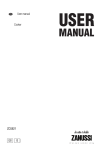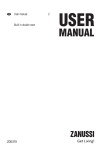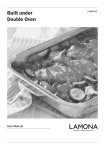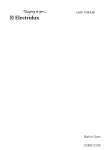Download U41116
Transcript
U41116 User manual Built in double oven 2 Contents Thank you for choosing one of our high-quality products. To ensure optimal and regular performance of your appliance please read this instruction manual carefully. It will enable you to navigate all processes perfectly and most efficiently. To refer to this manual any time you need to, we recommend you to keep it in a safe place. And please pass it to any future owner of the appliance. We wish you much joy with your new appliance. Contents Operating Instructions Safety information Product description General overview Control Panel Overview Oven accessories Before first use Preparing to use your appliance Cookware Setting the Time Initial Cleaning Operation The top oven Oven Functions Clock Functions Countdown Cook time End time Cook time and End time combined Use, tables and tips Roasting Top Oven - Conventional Cooking Top Oven - Grilling Main Oven - True Fan - Baking 2 2 4 4 5 5 6 6 7 7 7 8 8 8 9 9 10 10 10 10 12 13 15 15 Main Oven - True Fan - Roasting 16 Care and cleaning 17 Shelf supports 18 Replacing the side oven lamp/Cleaning the glass cover (for selected models only) 19 Oven back lamp (for selected models only) 20 Oven door 20 Oven door glass 22 Cleaning the outside of the appliance 25 Cleaning inside the grill and oven compartments 26 What to do if… 26 Installation Instructions 27 Installation Electrical Installation Disposal 27 29 30 Guarantee/Customer Service GREAT BRITAIN & IRELAND Environment concerns 31 31 32 Subject to change without notice Operating Instructions Safety information These warnings are provided in the interests of your safety. Ensure that you understand them all before installing or using the appliance. Safety information 3 Your safety is of paramount importance. If you are unsure about any of the meanings of these warnings please contact customer care. Installation • The appliance must be installed according to the instructions supplied. • The installation work must be undertaken by a qualified electrician or competent person. • The appliance should be serviced by an authorised Service Engineer and only genuine approved spare parts should be used. • The appliance must be installed in an adequately ventilated room. • It is imperative that the appliance is left in the base to protect both the appliance and the floor. • This appliance is heavy and care must be taken when moving it. Always wear safety gloves. • Do not attempt to lift or move this appliance by the handles. • All packaging, both inside and outside the appliance must be removed before the appliance is used. • It is dangerous to alter the specifications or modify the appliance in any way. Child safety • Do not allow children to play with any part of the packaging. • Do not allow children to sit or climb on the drop down doors. • This appliance is not intended for use by children and other persons whose physical, sensory or mental capabilities or lack of experience and knowledge prevents them from using the appliance safely without supervision or instruction by a responsible person to ensure that they can use the appliance safely. • Children should be supervised to ensure that they do not play with the appliance. CAUTION! Accessible parts may be hot. Young children should be kept away. During use WARNING! Never leave the appliance unattended when the oven door is open. • This appliance is not intended to be operated by means of an external timer or separate remote control system. • This appliance has been designed for domestic use to cook edible foodstuffs only and must not be used for any other purposes. • Take great care when heating fats and oils as they will ignite if they become too hot. • Never place plastic or any other material that may melt in or on the oven. • Always support the grill pan when it is in the withdrawn or partially withdrawn position. • Always use oven gloves to remove and place food in the oven. • During use the appliance becomes hot. Care should be taken to avoid touching the heating elements inside the oven. • Ensure that all vents are not obstructed to ensure ventilation of the oven cavity. • Never line any part of the appliance with foil. • Always stand back from the appliance when opening the oven door to allow any build up of steam or heat to release. 4 Product description • Stand clear when opening the drop down doors. Support the doors using the handles until fully open. • Do not place sealed cans or aerosols inside the oven. They may explode if they are heated. • Ensure that all control knobs are in the OFF position when not in use. • Do not stand on the appliance or on the open oven doors. • Do not hang towels, dishcloths or clothes from the appliance or its handles. • Do not use this appliance if it is in contact with water. Never operate it with wet hands. Cleaning and maintenance WARNING! For hygiene and safety reasons this appliance should be kept clean at all times. A build-up of fat or other foodstuff could result in a fire especially in the grill pan. • Do not leave cookware containing foodstuffs, e.g. fat or oil in the appliance in case it is inadvertently switched on. • Always allow the appliance to cool before switching off at the wall prior to carrying out any cleaning/maintenance work. • Only clean this appliance in accordance with the instructions given in this book. • Never use steam or high pressure steam cleaners to clean the appliance. Product description General overview 1 2 3 4 5 1 2 3 4 Control panel Top oven handle Top oven Main oven handle Product description 5 Main oven Control Panel Overview 1 2 8 3 1 2 3 4 5 6 7 8 Top oven function knoob Top oven temperature knob Decrease button Mode button Increase button Main oven function knob Main oven temperature knob Display Oven accessories 3 oven shelfs Oven grill shelf 4 6 5 7 5 6 Before first use Anti stick meat/Drip pan Before first use Rating plate This is situated on the front frame of the appliance and can be seen upon opening the door. Alternatively the rating plate may also be found on the back or top of some models (where applicable). The appliance must be protected by a suitably rated fuse or circuit breaker. The rating of the appliance is given on the rating plate. WARNING! Do not remove the rating plate from the appliance as this may invalidate the guarantee. Preparing to use your appliance Wipe over the base of the oven(s) with a soft cloth using hot soapy water. Wash the furniture before use. We suggest that you run the oven(s) and grill for 10 – 15 minutes at maximum temperature, to burn off any residue from their surfaces. Accessible parts may become hotter than in normal use. Children should be kept away. During this period an odor may be emitted, it is therefore advisable to open a window for ventilation. The cooling fan The cooling fan comes on immediately the top oven or grill is switched on. It may run on after the ovens are switched off until the appliance has cooled. During the cooling down period the cooling fan may switch on and off. WARNING! Always allow the cooling fan to cool the appliance down before switching off the electrical supply to carry out cleaning or maintenance. Control panel indicator neon(s) The indicator neon will operate when the oven(s) is switched on. The indicator neon will glow. It may turn on and off during use to show that the setting is being maintained. If the neon does not operate as the instructions indicate the controls have been incorrectly set. Return all controls to zero and reset following the instructions for the required setting. Before first use 7 Condensation and steam When food is heated it produces steam similar to a boiling kettle. The vents allow some of this steam to escape. However, always stand back from the appliance when opening the door(s) to allow any build up of steam or heat to release. If the steam comes into contact with a cool surface on the outside of the appliance, e.g. a trim, it will condense and produce water droplets. This is quite normal and is not caused by a fault on the appliance. To prevent discoloration, regularly wipe away condensation and foodstuff from surfaces. For your safety wall coverings at the rear of the appliance should be securely fixed to the wall. Cookware Baking trays, dishes etc., should not be placed directly against the grid covering the fan at the back of the oven. Do not use baking trays larger than 30cm x 35cm (12” x 14”) as they will restrict the circulation of heat and may affect performance. Setting the Time The oven only operates when the time has been set. 1. When the appliance is connected to the electrical supply or when there has been a power cut, Time flashes automatically. 2. Using the or button, set the current time. 3. After approx. 5 seconds, the clock stops flashing and the clock displays the time of day set. The appliance is now ready to use. Initial Cleaning Before using the oven for the first time you should clean it thoroughly. WARNING! Do not use any caustic, abrasive cleaners! The surface could be damaged. To clean metal fronts use commercially available cleaning agents. 1. Turn the oven function switch to oven lighting . 2. Remove all accessories and the shelf support rails and wash them with warm water and washing up liquid. 8 Operation 3. Then wash out the oven with warm water and washing-up liquid, and dry. 4. Wipe the front of the appliance with a damp cloth. Operation The top oven The top oven is the smaller of the two ovens. It is heated by elements in the top and bottom of the oven. It is designed for cooking smaller quantities of food. It gives especially good results if used to cook fruitcakes, sweet and savoury flans or quiche. The top oven is ideal for use as a warming compartment. It can be used to warm dishes and keep food hot. Use the lowest setting on the top oven temperature control. WARNING! Do not place cookware and cooking pots with rough bases e.g. cast iron on the oven door as damage to the glass may occur. Always grill with the door closed. Switching the Oven On and Off 1. Turn the oven functions dial to the desired function. 2. Turn the temperature selector to the desired temperature. 3. To turn the oven off, turn the oven functions dial and the temperature selector to the Off position. The power indicator is lit as long as the oven is in operation. The temperature pilot light is lit as long as the oven is heating up. The fan switches on automatically in order to keep the appliance’s surfaces cool. When the oven is switched off, the fan continues to run to cool the appliance down, then switches itself off automatically. Oven Functions Top Oven Oven function Application Light Using this function you can light up the oven interior, e.g. for cleaning. Conventional Cooking This form of cooking gives you the opportunity to cook without the fan in operation. It is particularly suitable for dishes, which require extra base browning such as pies, quiches and flans. Gratin's, lasagne and hot pots which require extra top browning also cook well in the conventional oven. For best results cook on one level. Operation 9 Oven function Application Top Heat Browning This function uses the top element to give single level cooking. This is particularly suitable for dishes which require extra top browning. Base Heat Finishing For baking cakes with crispy or crusty bases. Economy Grill For grilling flat foodstuffs placed in the middle of the grill and for toasting. Full Grill For grilling flat foodstuffs in large quantities and for toasting. Bottom Oven Oven function Application Light Using this function you can light up the oven interior, e.g. for cleaning. True Fan The fan function is particularly suitable for cooking larger quantities of food. Set the oven temperatures 20-40 °C lower than when using Conventional. Fan Conrolled Defrosting For defrosting e. g. flans and gateaux, butter, bread, fruit or other frozen foods. Clock Functions • Countdown - See appropriate chapter on setup. A signal sounds after the time has elapsed. This function does not affect the functioning of the oven. - is used to set the desired period of cooking time. • Cook time - when set the appliance is turned off at desired time. • End time • Time - shows the current time. How to use the clock functions • After a function has been selected, the corresponding function indicator flashes for about 5 seconds. During this period, the desired times can be set using the increase or decrease button. • When the desired time has been set, the function indicator continues to flash for approx. 5 seconds. After that the function indicator is then lit. The set time begins to run. • Press any of the buttons to stop the audible signal. • The desired oven function and temperature can be selected before or after the clock and End time are set. functions Cook time • When the cooking process is completed, turn the oven function dial and the temperature selector back to the OFF position. Countdown 1. Press the Mode button repeatedly until the function indicator Countdown flashes. 2. Using the increase or decrease button set the desired Countdown (max. 2 hours 30 minutes). 3. After approx. 5 seconds the display shows the time remaining. The function indicator Countdown lights up. 4. When the time has elapsed, the function indicator flashes and an audible signal sounds for 2 minutes. The signal can be stopped by pressing any button. 10 Use, tables and tips Cook time 1. Press the Mode button repeatedly until the function indicator Cook time flashes. 2. Using the increase or decrease button set the desired cooking time. After approx. 5 seconds the display returns to showing the current time. The function lights up. indicator Cook time When the time has elapsed, the function indicator flashes, an audible signal sounds for 2 minutes and the oven switches itself off. 3. The signal and the programme can be stopped by pressing any button. End time 1. Press the Mode button repeatedly until the function indicator End time flashes. 2. Using the increase or decrease button set the desired switch-off time. After approx. 5 seconds the display returns to showing the current time. The function indicator End time lights up. When the time has elapsed, the function indicator flashes, an audible signal sounds for 2 minutes and the oven switches itself off. 3. The signal and the programme can be stopped by pressing any button. Cook time and End time combined Cook time and End time can be used simultaneously, if the oven is to be switched on and off automatically at a later time. function, set the time required for cooking the dish. 1. Using the Cook time function, set the time at which the dish should be ready. 2. Using the End time The function indicators Cook time and End time light up and the current time is shown in the display. The oven switches on automatically at the time calculated. And switches itself off again when the cooking time entered has elapsed. Use, tables and tips Baking Oven levels • Baking with Conventional Cooking is only possible on one level. • When baking with Fan Cooking one to two baking trays can be put into the bottom oven at the same time: 1 tray, e.g. oven level 3 Use, tables and tips 11 1 cake in cake tin, e.g. oven level 1 2 tray, e.g. oven levels 1 and 3 Baking tins • Baking tins made from dark-coloured metal with Teflon coating are suitable for baking using Conventional Cooking. • For baking using the Fan Cooking function, baking tins made of shiny light-coloured metal are suitable. General instructions • Insert the tray with the bevel at the front. • When baking using Conventional Cooking and Fan Cooking , you can also place two baking trays next to one another on one level. This does not significantly affect the baking time. When frozen items are placed on baking trays, they can buckle during cooking. This happens due to the large difference in temperature between the frozen item and the oven. After cooling, the buckling in the trays disappears. How to use the Baking Tables • The tables give the required temperature settings, cooking times and oven levels for a selection of typical dishes. • Temperatures and baking times are for guidance only, as these will depend on the consistency of pastry, dough or mixture, the amount and the type of baking tin. • We recommend setting the oven to a lower temperature for the first time and only setting a higher temperature when required, e.g. if you require more browning or if the baking is taking too long. • If you cannot find the settings for a certain recipe, look for similar items. • The baking time can be 10-15 minutes longer when baking cakes on trays or in tins on multiple levels. • Recipes with moist ingredients such as pizzas or fruit flans are to be baked on one level. • Cakes and pastries at different heights may brown at an uneven rate at first. You should not change the temperature setting if this occurs. Different rates of browning even out as baking progresses. 12 Use, tables and tips • Baking and roasting times could differ from those of your previous oven. For this reason you should adjust the settings you usually use (temperature, cooking times, etc.) and oven levels to the recommendations provided in the following tables. Roasting Ovenware for roasting • Any heat-resistant ovenware is suitable to use for roasting. (Please follow the manufacturer's instructions.) • You can place large roasts directly in the roasting tray or on the shelf with the roasting tray underneath. • We recommend roasting leaner cuts in a roasting pan with a lid. The meat will be more succulent. • All types of meat which are supposed to be browned or form a crust or crackling can be roasted in a roasting pan without a lid. The information given in the following tables is for guidance only. • We recommend meat and fish weighing 1 kg or more for roasting in the oven. • To prevent escaping meat juices or fat from burning on to the pan, we recommend placing some liquid in the roasting cookware. • If required, turn the roast after 1/2 - 2/3 of the cooking time. • Use the cooking juices to baste large roasts and poultry several times during the cooking time. This will give better roasting results. Hints and tips when using the grill • Most foods should be placed on the grid in the grill pan to allow maximum circulation of air and to lift the food out of the fats and juices. • Adjust the grid and grill pan runner position to allow for different thicknesses of food. • Position the food close to the element for faster cooking and further away for gentler cooking. • Food should be thoroughly dried before grilling to minimise splashing. Brush lean meats and fish lightly with a little oil or melted butter to keep them moist during cooking. • Accompaniments such as tomatoes and mushrooms may be placed underneath the grid when grilling meats. • When toasting bread, use the shelf in the top position with the grid in the ‘high’ position. • Preheat the grill on a full setting for a few minutes before sealing steaks or toasting. Adjust the heat setting and the shelf as necessary during cooking. • The food should be turned over during cooking as required. • When using the centre section grill, ensure food is placed centrally on the grilling grid directly beneath the grill element. Hints and tips when using the top oven • Arrange the shelves in the required positions before switching the oven ON. Shelf positions are counted from the bottom upwards. • There should always be at least 2.5cm (1”) between the top of the food and the element. This gives best cooking results and allows room for rise in yeast mixtures, Yorkshire puddings etc. When cooking cakes, pastry, scones bread etc., place the tins or baking trays centrally on the shelf. Use, tables and tips 13 • Ensure that food is placed centrally on the shelf and there is sufficient room around the baking tray/dish to allow for maximum circulation. • Stand dishes on a suitably sized baking tray on the shelf to prevent spillage onto the oven base and to help reduce cleaning. • The material and finish of the baking tray and dishes used affect base browning. Enamelware, dark, heavy or non-stick utensils increase base browning. Shiny aluminium or polished steel trays reflect the heat away and give less base browning. • Because of the smaller cooking space and lower temperatures, shorter cooking times are sometimes required. Be guided by the recommendations given in the cooking chart. • For economy leave the door open for the shortest possible time, particularly when placing food into a pre-heated oven. Hints and tips when using fan cooking • Arrange the shelves in the required positions before switching the oven on. Shelf positions are counted from the bottom upwards. • When cooking more than one dish in the fan oven, place dishes centrally on different shelves rather than placing several dishes on one shelf, this will allow the heat to circulate freely for the best cooking results. • When batch baking one type of food, e.g. Victoria sandwich cakes, those of similar size will be cooked in the same time. • It is recommended that when baking larger quantities the shelf positions should be evenly spaced to suit the load being cooked. A slight increase in cooking time may be necessary. • Do not place baking trays directly on the oven base as it interferes with the oven air circulation and can lead to base burning; use the lower shelf position. Hints and tips when defrosting • Place the frozen food in a single layer where possible and turn it over half way through the defrosting process. • The actual speed of defrosting is influenced by room temperature. On warm days defrosting will be faster than on cooler days. • It is preferable to thaw fish, meat and poultry slowly in the fridge. However, this process can be accelerated by using the defrost function. Small or thin fish fillets, frozen peeled prawns, cubed or minced meat, liver, thin chops, steaks etc., can be thawed in 1 – 2 hours. • A 1kg/2¼lb oven ready chicken will be thawed in approximately 5 hours. Remove the giblets as soon as possible during the thawing process. • Joints of meat up to 2kg/4½lb in weight can be thawed using the defrost function. • All joints of meat and poultry must be thawed thoroughly before cooking. • Always cook thoroughly immediately after thawing. • Do not leave food at room temperature once it is defrosted. Cook raw food immediately or store cooked food in the fridge, once it has cooled. Top Oven - Conventional Cooking Shelf Positions are not critical but ensure that oven shelves are evenly spaced when more than one is used (e.g. shelf positions 1 and 3) 14 Use, tables and tips Temperature [°C] Approx Cook Time (mins) Shelf Position Biscuits 170 - 190 10 - 20 1 Bread 200 - 220 30 - 35 1 Bread rolls/buns 200 - 220 10 - 15 1 - Small & Queen 170 - 180 18 - 25 1 - Sponges 160 - 175 20 - 30 1 - Victoria Sandwich 160 - 170 18 - 25 1 - Madeira 140 - 150 75 - 90 1 - Rich Fruit 140 - 150 120 - 150 1 - Gingerbread 140 - 150 75 - 90 1 - Meringues 90 - 100 150 - 180 1 - Flapjack 160 - 170 25 - 30 1 - Shortbread 130 - 150 45 - 65 1 - Beef/Lamb 150 - 170 150 - 180 1 - Chicken 160 - 180 75 - 90 1 Food Cakes: Casseroles: Convenience Foods Follow manufacturer´s instructions. Fish 170 - 190 20 - 30 1 Fish Pie (Potato Topped) 190 - 200 20 - 30 1 Fruit Pies, Crumbles 190 - 200 30 - 50 1 Milk Puddings 150 - 170 90 - 120 1 Pasta Lasagne etc. 170 - 180 40 - 50 1 - Choux 180 - 190 30 - 40 1 - Eclairs, Profiteroles 180 - 190 30 - 40 1 - Flaky/Puff Pies 210 - 220 30 - 40 1 - Mince Pies 190 - 200 15 - 20 1 - Meat Pies 190 - 210 25 - 35 1 - Quiche, Tarts, Flans 180 - 200 25 - 50 1 Scones 220 - 230 8 - 12 1 Shepard´s Pie 190 - 200 30 - 40 1 Pastry: Shortcrust: Use, tables and tips Temperature [°C] Approx Cook Time (mins) Shelf Position 180 - 190 20 - 30 1 - Baked Jacket Potatoes 180 - 190 60 - 90 1 - Roast Potatoes 180 - 190 60- 90 1 - Large 200 - 210 25 - 40 1 - Individual 210 - 220 15 - 25 1 Food Soufflés 15 Vegetables: Yorkshire Pudding: Roasting Meat, Poultry See roasting chart. Top Oven - Grilling Adjust shelf position and grill pan grid to suit different thicknesses of food Food Bacon Rashers Grill Time (mins in total) 5- 6 Beefburgers 10 - 20 Chicken Joints 20 - 40 Chops - Lamb 15 - 25 - Pork 20 - 25 Fish - Whole Trout/ Makarel 10 -12 Fillets - Plaice/Cod 4-6 Kebabs 12 - 18 Kidneys - Lamb/Pig 6 - 10 Sausages 20 - 30 Steaks - Rare 4-6 - Medium 6-8 - Well Done Toasted Sandwiches 12 - 15 3-4 Main Oven - True Fan - Baking Shelf Positions are not critical but ensure that oven shelves are evenly spaced when more than one is used (e.g. shelf positions 1 and 3) 16 Use, tables and tips Temperature [°C] Approx Cook Time (mins) Biscuits 180 - 190 10 - 20 Bread 190 - 210 30 - 35 - Small & Queen 160 - 170 18 - 25 - Sponges 160 - 170 20 - 25 - Madeira 140 - 160 60 - 75 - Rich Fruit 130 - 140 120 - 150 - Christmas 130 - 140 180 - 270 Fish 160 - 180 20 - 30 Fruit Pies, Crumbles 170 - 180 30 - 50 Milk Puddings 140 - 160 60 - 90 - Choux 180 - 190 30 - 40 - Shortcrust 180 - 190 25 - 35 180 - 190 30 - 40 depends on size Food Cakes: Pastry: - Flaky - Puff Follow manufacturer´s instructions; Reduce the temperature for Fan oven by 20°C Plate Tarts 180 - 190 25 - 45 Quiches/Flans 170 - 180 25 - 45 Scones 210 - 230 8 - 12 Roasting: Meat and Poultry 160 - 180 see Roasting Chart Main Oven - True Fan - Roasting Meat Beef/ Beef boned Mutton/ Lamb Pork/ Veal/ Ham Chicken Turkey/ Goose Duck Temperature [°C] Cooking Time 160 - 180 20-35 minutes per ½ kg (1lb) and 20-35 minutes over 160 - 180 20-35 minutes per ½ kg (1lb) and 20-35 minutes over 160 - 180 30-40 minutes per ½ kg (1lb) and 30-40 minutes over 160 - 180 15-20 minutes per ½ kg (1lb) and 20 minutes over 160 - 180 15-20 minutes per ½ kg (1lb) and 20 minutes over 160 - 180 25-35 minutes per ½ kg (1lb) and 25-30 minutes over Care and cleaning Meat Pheasant Rabbit 17 Temperature [°C] Cooking Time 160 - 180 35-40 minutes per ½ kg (1lb) and 35-40 minutes over 160 - 180 20 minutes per ½ kg (1lb) and 20 minutes over Care and cleaning WARNING! When cleaning, the appliance must be switched off and cooled down. WARNING! Cleaning the appliance with a steam jet or high-pressure cleaner is prohibited for safety reasons. CAUTION! Do not use scourers, sharp tools or rinsing devices to clean the appliance. Do not use scourers or metal scrapers to clean the glass oven door, as these could scratch the surface. This could cause the glass to shatter. The outside of the appliance • Wipe the front of the appliance with a soft cloth and a solution of warm water and washing-up liquid. • For metal surfaces use standard commercial cleaning products. • Please do not use any scouring agents or abrasive sponges. Clean the oven after every use. This is the easiest way to remove dirt which then cannot burn on. Inside of the oven 1. When the oven door is opened, the oven light bulb automatically illuminates. 2. Wipe out the oven after every use with a solution of washing-up liquid and then dry it. Remove stubborn dirt with special oven cleaners. Important: When using oven sprays, please follow the manufacturer's instructions exactly. Make sure that no visible remaining detergents are left after the cleaning with oven spray! Accessories • Clean and dry the oven accessories (shelf, tray, roasting pan, etc.) after each use. Soak the items to make cleaning easier. Catalytic cavity cleaning (selected models only) WARNING! You must not wipe out the cavity side walls. It will damage the catalytic surface. 1. Remove all slide-in parts from the oven. 18 Care and cleaning 2. Wipe the floor of the oven clean with warm washing-up solution and dry. 3. Set the oven with max temp. of 275 C for 30 min (use Conventional Cooking or True Fan function). 4. Oven will switch off after one hour. 5. Wipe away any remaining a damp from the floor with soft sponge. WARNING! Before you wipe away wait until the cavity is cool. WARNING! Do not use oven spray or abrasive cleaning agents. Do not use soap or other cleansing agents. The catalytic coating may otherwise be damaged. After long periods of use, the catalytic coating may become slightly discoloured. This has no effect on the catalytic properties. Shelf supports The left and right-hand side rails can be removed from the oven, so that the side walls of the oven can be cleaned. Removing the slide-in racks First pull the front of the rails away from the oven wall (1), and then unhook them at the back (2). Care and cleaning 19 Inserting the side rails Attention! The rounded ends of the guide bars must point to the front! To insert, first insert the rails in the holes at the back (1) and then lower into position at the front and press into place (2). 1 2 Replacing the side oven lamp/Cleaning the glass cover (for selected models only) 1. Take out the left side rail. 2. Remove the glass cover by using a narrow, blunt object (e.g. a teaspoon) and clean it. 20 Care and cleaning 3. If necessary: Replace oven halogen light bulb. Order a replacement bulb from customer services (see "Service / Customer Service") Always take hold of the halogen light bulb with a cloth to avoid burning on grease residues. 4. Re-fit the glass cover. 5. Replace the side rails. Oven back lamp (for selected models only) WARNING! Risk of electric shock! Before replacing the oven light bulb: – Switch off the oven! – Take the fuses out of the fuse box or switch off. To protect the oven light bulb and the glass cover, lay a cloth on the floor of the oven. Replacing the oven light bulb/Cleaning the glass cover 1. Take off the glass cover by turning it anticlockwise and clean it. 2. If necessary: Replace with a 40 Watt, 230V, 300°C heat-resistant oven light bulb . 3. Re-fit the glass cover. Oven door You can unhinge the oven door to clean it. Removing the oven door from its hinges 1. Open the oven door as far as it will go. 90° Care and cleaning 2. Undo the clamping levers (A) on both door hinges fully . 21 A A 3. Close the oven door as far as the first position (approx. 45°). 45° 4. Take hold of the sides of the oven door with both hands and pull the door up and diagonally away from the oven ( caution: The door is heavy). Lay the oven door with the outer side facing downwards on something soft and level, for example, a blanket in order to prevent scratches. Fitting the oven door 1. From the handle side take hold of the oven door with a hand on each side and hold at an angle of approx. 45°. Align the slots on the bottom of the oven door with the oven tracks. Let the door slide until it clicks in place. 22 Care and cleaning 2. Open the oven door as far as it will go. 90° 3. Click the clamping levers (A) on both door tracks back to their original position. A 4. Close the oven door. Oven door glass The oven door is fitted with four panels of glass mounted one behind the other. The inner glass panels can be removed for cleaning. Attention: Rough handling, especially around the edges of the front panel, can cause the glass to break. Removing door glass panels 1. Open the oven door as far as it will go. 90° Care and cleaning 2. Undo the clamping levers (A) on both door hinges fully . 23 A A 3. Close the oven door as far as the first position (approx. 45°). 45° 4. Take hold of the door cover (B) at the top on both sides and push inwards to release the clip lock. Then remove the door trim by pulling it upwards. B 5. Take hold of the door glass panels on their upper edge one after the other and take them out of the guide by pulling them upwards. Cleaning the door glass panels Clean the door glass panels thoroughly with soapy water. Then dry them carefully. CAUTION! Do not use abrasive substances or metal scrapers to clean the glass oven door, as this could scratch the surface. This could cause the glass to shatter. 24 Care and cleaning Putting the door glass panels back 1. Slide the door glass panels one by one at an angle from above into the door panel at the bottom edge of the door and let them slide down. Insert the two smaller panels first, followed by the largest. 2. Take hold of the door cover (B) on the sides, place on the inside of the door edge and attach the door cover (B) to the door's upper edge. B There is a guiding track (C) on the open side of the door cover (B). Insert this between the outer door panel and the guiding bracket (D). The clip seal (E) must be snapped in. C D E Care and cleaning 25 3. Open the oven door as far as it will go. 90° 4. Click the clamping levers (A) on both door tracks back to their original position. A 5. Close the oven door. WARNING! Before cleaning always allow the appliance to cool down before switching off at the electricity supply. Cleaning materials Before using any cleaning materials on your appliance, check that they are suitable and that their use is recommended by the manufacturer. Cleaners that contain bleach should not be used as they may dull the surface finishes. Harsh abrasives and scourers should also be avoided. Cleaning the outside of the appliance Do not use abrasive cleaning materials e.g. abrasive cream cleaners, wire wool pads or scourers on painted or printed finishes as damage may occur. Regularly wipe over the control panel, control knobs, handles, doors and appliance sides using a soft cloth and hot soapy water. To prevent streaking, finish with a soft cloth. Stainless Steel cream cleaners are abrasive and should be avoided as they may dull the surface finish. Any spillage on the stainless steel finish must be wiped off immediately. 26 What to do if… WARNING! Do not attempt to remove any of the control knobs from the appliance as this may cause damage and is a safety hazard. Cleaning inside the grill and oven compartments The vitreous enamel coating in the grill/top oven and main oven compartments can be cleaned using normal oven cleaners with care. Ensure that the manufacturers instructions are followed and that all parts are well rinsed afterwards. WARNING! Aerosol cleaners must not come into contact with elements, the door seal, or any painted finishes as this may cause damage. Cleaning the door(s) WARNING! Under no circumstances should the door assembly be detached from the product for cleaning. WARNING! To prevent damaging or weakening the door glass panels avoid the use of the following: • Household detergents and bleaches. • Soap Impregnated pads unsuitable for non-stick saucepans. • Abrasive cleaning pads, scorers and steel wool pads. • Chemical oven pads or aerosols. • Rust removers. • Bath/Sink stain removers. Cleaning between the outer and inner door glass The door glass is removable for cleaning. Clean the outer and inner glass using hot soapy water or hob cleaner may be used. Do not use hob cleaner on the Stainless Steel or painted finishes. Ensure that all parts are well rinsed and thoroughly dried before attempting to replace the outer door. What to do if… WARNING! Repairs to the appliance must only be carried out by qualified service engineers. Considerable danger to the user may result from improper repairs. In the case of misuse the visit by the Customer Care Department technician or the repair may be chargeable, even during the warranty period. Information for appliances with metal fronts: Due to the appliance's cool front, when the door is opened during or shortly after baking or roasting, there may be condensation of the inner glass panel for a short while. Installation 27 Please carry out the following checks on your appliance before calling a Service Engineer. It may be that the problem is a simple one which you can solve yourself without the expense of a service call. In-guarantee customers should make sure that the checks have been made as the engineer will make a charge if the fault is not a mechanical or electrical breakdown. Please note that proof of purchase is required for in-guarantee service calls. Problem Possible Solution The grill, ovens and timer do not Check that the appliance has been wired in to the appliance work. supply and is switched on at the wall. Check that the main appliance fuse is working. If you have checked the above: Allow the appliance to cool for a couple of hours. The appliance should now be working normally. The grill does not work or cuts out after being used for a long period of time. Ensure the cooling fan is running when the grill is on. If the cooling fan fails, the grill will not operate correctly. Contact your local service force centre. Leave the grill door open and allow the grill to cool. After a couple of hours check that the grill works as normal The indicator neons are not working correctly. Check that you have selected only the function you require. Ensure all other controls are in the off position. The oven is not cooking evenly. Check that the appliance is correctly installed and is level. Check that the recommended temperatures and shelf positions are being used. The oven light fails to illuminate. The oven light bulb may need replacing. The oven fan is noisy. Check that the oven is level. Check that the shelves and bakeware are not vibrating in contact with the oven back panel. The oven temperature is too high Check that the recommended temperatures and shelf positions or too low. are being used. Be prepared to adjust the temperature up or down slightly to achieve the results you want. Installation Instructions Installation • The set-up of the electrical installation is arranged so that the appliance can be isolated from the mains with a minimum 3 mm all-pole contact separation. Suitable isolation devices include, for example, circuit breakers, fuses (screw type fuses are to be removed from the holder), RCDs and contactors. • Anti-shock protection must be provided by the installation. • The built-in unit must meet the stability requirements of DIN 68930. Installation • Built-in cookers and cooking surfaces are equipped with special attachment systems. For safety reasons, they must only be combined with appliances from the same manufacturer. The use of heat protection strips is prohibited for cookers and ovens with Pyrolytic Cleaning, if the recess has a rear wall and closed ground-level compartment. However installation is possible with a ground-level compartment that has been shortened by at least 20 mm and which has base ventilation of the same cross-section. 1 2 720 28 600 - 605 40 mm 90° 320 mm 551 mm 720 mm 320 mm 90° 364 mm 560 mm Installation 29 2x 3,5x16 Drill with drilling machine at high revolution and lowest torque. Electrical Installation • Enquiries regarding the installation of the cooker point, if required, should be made to your Regional Electricity Company to ensure compliance with their regulations. • The appliance socket switch should be outside the cabinet but within 2m of the appliance to make it accessible to switch off the appliance in case of an emergency. • To protect the hands, wear gloves when lifting the oven into its housing. HOUSE CIRCUIT Earth leakage and continuity tests must be carried out before the appliance is connected to the mains supply and re-checked after fitting. GETTING THINGS READY CHOICE OF ELECTRICAL CONNECTION There are three possible ways to connect your appliance. In each case the appliance should be operated using at least 6mm² twin core and earth PVC insulated multicore cable. Please choose from the most appropriate after reading the different methods : a) By connecting to a cooker point (having a double pole isolating switch with at least 3mm contact separation in all poles and neutral) and protected with a fuse or miniature circuit breaker at your mains fuse box. b) By connecting the appliance together with a hob directly to a cooker point(s). Having a double pole isolating switch with at least 3mm contact separation in all poles and neutral. c) If you wish to connect an oven and a hob to a cooker point you can by connecting the oven and hob separately to the cooker point. Oven and hob units should be separately connected to a cooker point. (See Picture) 30 Disposal 1 Cooker Point 2 Hob 3 Oven 1 3 2 It is good practice to : – Fit an Earth Leakage Circuit Breaker to your house wiring. – Wire your appliance to the latest IEE regulations. Disposal The symbol on the product or on its packaging indicates that this product may not be treated as household waste. Instead it should be taken to the appropriate collection point for the recycling of electrical and electronic equipment. By ensuring this product is disposed of correctly, you will help prevent potential negative consequences for the environment and human health, which could otherwise be caused by inappropriate waste handling of this product. For more detailed information about recycling of this product, please contact your local council, your household waste disposal service or the shop where you purchased the product. Packaging material The packaging material is environmentally-friendly and recyclable. Plastic parts are marked with the international abbreviations such as, e.g. >PE <, >PS< etc. Dispose of the packaging material in the containers provided for this purpose at your local waste management facility. WARNING! Your appliance should be made inoperable before it is disposed of, so that it does not constitute a danger. To do this, take the mains plug from the socket and remove the mains cable from the appliance. Guarantee/Customer Service GB IE 31 Guarantee/Customer Service GREAT BRITAIN & IRELAND Standard guarantee conditions We, Electrolux, undertake that if within 12 months of the date of the purchase this Electrolux appliance or any part thereof is proved to be defective by reason only of faulty workmanship or materials, we will, at our option repair or replace the same FREE OF CHARGE for labour, materials or carriage on condition that: • Appliance has been correctly installed and used only on the electricity supply stated on the rating plate. • Appliance has been used for normal domestic purposes only, in accordance with manufacturer's instructions. • Appliance hasn't been serviced, maintained, repaired, taken apart or tampered with by person not authorised by us. • Electrolux Service Force Centre must undertake all service work under this guarantee • Any appliance or defective part replaced shall become the Company's property. • This guarantee is in addition to your statutory and other legal rights. Exclusions • Damage, calls resulting from transport, improper use, neglect, light bulbs, removable parts of glass, plastic. • Costs for calls to put right appliance which is improperly installed, calls to appliances outside United Kingdom. • Appliances found to be in use within a commercial environment, plus those which are subject to rental agreements. • Products of Electrolux manufacturer that are not marketed by Electrolux Service and Spare Parts If your appliance requires service or spare parts, contact your local Service Force Centre: 0870 5 929 929 (Call will be routed to Service Force Centre covering your postcode area). For address of local Service Force Centre and further information, please visit: www.serviceforce.co.uk Before calling out an engineer, please ensure you have read the details under the heading "What to do if..." When you contact the Service Force Centre you will need to give the following details: Your name, address and postcode, your telephone number, clear concise details of the fault, model and serial number of the appliance (found on the rating plate), the purchase date. Please note a valid purchase receipt or guarantee documentation is required for in guarantee service calls. Customer Care For general enquiries concerning your Electrolux appliance, or for information on Electrolux products, contact our Customer Care Department by letter or telephone at the address below or visit our website at www.electrolux.co.uk Customer Care Department, Electrolux Major Appliances, Addington Way, Luton, Bedfordshire, LU4 9QQ 32 Environment concerns Tel: (Calls may be recorded for training purposes) Electrolux 08705 950 950 AEG-Electrolux 08705 350 350 Zanussi-Electrolux 08705 727 727 For Customer Service in The Republic of Ireland please contact us at the address below: Electrolux Group (Irl) Ltd, Long Mile Road, Dublin 12, Republic of Ireland Tel: +353 (0)1 4090751, Email: [email protected] Environment concerns The symbol on the product or on its packaging indicates that this product may not be treated as household waste. Instead it should be taken to the appropriate collection point for the recycling of electrical and electronic equipment. By ensuring this product is disposed of correctly, you will help prevent potential negative consequences for the environment and human health, which could otherwise be caused by inappropriate waste handling of this product. For more detailed information about recycling of this product, please contact your local council, your household waste disposal service or the shop where you purchased the product. Albania +35 5 4 261 450 Rr. Pjeter Bogdani Nr. 7 Tirane Belgique/België/Belgien +32 2 363 04 44 Bergensesteenweg 719, 1502 Lembeek Česká republika +420 2 61 12 61 12 Budějovická 3, Praha 4, 140 21 Danmark +45 70 11 74 00 Sjællandsgade 2, 7000 Fredericia Deutschland +49 180 32 26 622 Fürther Str. 246, 90429 Nürnberg Eesti +37 2 66 50 030 Pärnu mnt. 153, 11624 Tallinn España +34 902 11 63 88 Carretera M-300, Km. 29,900 Alcalá de Henares Madrid France 08 44 62 26 53 www.electrolux.fr Great Britain +44 8705 929 929 Addington Way, Luton, Bedfordshire LU4 9QQ Hellas +30 23 10 56 19 70 4, Limnou Str., 54627 Thessaloniki Hrvatska +385 1 63 23 338 Slavonska avenija 3, 10000 Zagreb Ireland +353 1 40 90 753 Long Mile Road Dublin 12 33 Italia +39 (0) 434 558500 C.so Lino Zanussi, 26 - 33080 Porcia (PN) Latvija +371 67313626 Kr. Barona iela 130/2, LV-1012, Riga Lietuva +370 5 278 06 03 Ozo 10a, LT-08200 Vilnius Luxembourg +352 42 431 301 Rue de Bitbourg, 7, L-1273 Hamm Magyarország +36 1 252 1773 H-1142 Budapest XIV, Erzsébet királyné útja 87 Nederland +31 17 24 68 300 Vennootsweg 1, 2404 CG - Alphen aan den Rijn Norge +47 81 5 30 222 Risløkkvn. 2 , 0508 Oslo Österreich +43 18 66 400 Herziggasse 9, 1230 Wien Polska +48 22 43 47 300 ul. Kolejowa 5/7, Warsza‐ wa Portugal +35 12 14 40 39 39 Quinta da Fonte - Edificio Gonçalves Zarco - Q 35 -2774-518 Paço de Arcos Romania +40 21 451 20 30 Str. Garii Progresului 2, S4, 040671 RO Schweiz - Suisse - Svizzera +41 62 88 99 111 Industriestrasse 10, CH-5506 Mägenwil Slovenija +38 61 24 25 731 Gerbičeva ulica 98, 1000 Ljubljana Slovensko +421 2 43 33 43 22 Electrolux Slovakia s.r.o., Electrolux Domáce spotrebiče SK, Seberíniho 1, 821 03 Bratislava Suomi www.electrolux.fi Sverige +46 (0)771 76 76 76 Electrolux Service, S:t Göransgatan 143, S-105 45 Stockholm Türkiye +90 21 22 93 10 25 Tarlabaşı caddesi no : 35 Taksim İstanbul Россия +7 495 937 7837 129090 Москва, Олимпийский проспект, 16, БЦ "Олимпик" Україна +380 44 586 20 60 04074 Київ, вул.Автозаводська, 2а, БЦ "Алкон" 34 35 www.electrolux.com 892930016-E-052009 www.aeg-electrolux.co.uk

























































